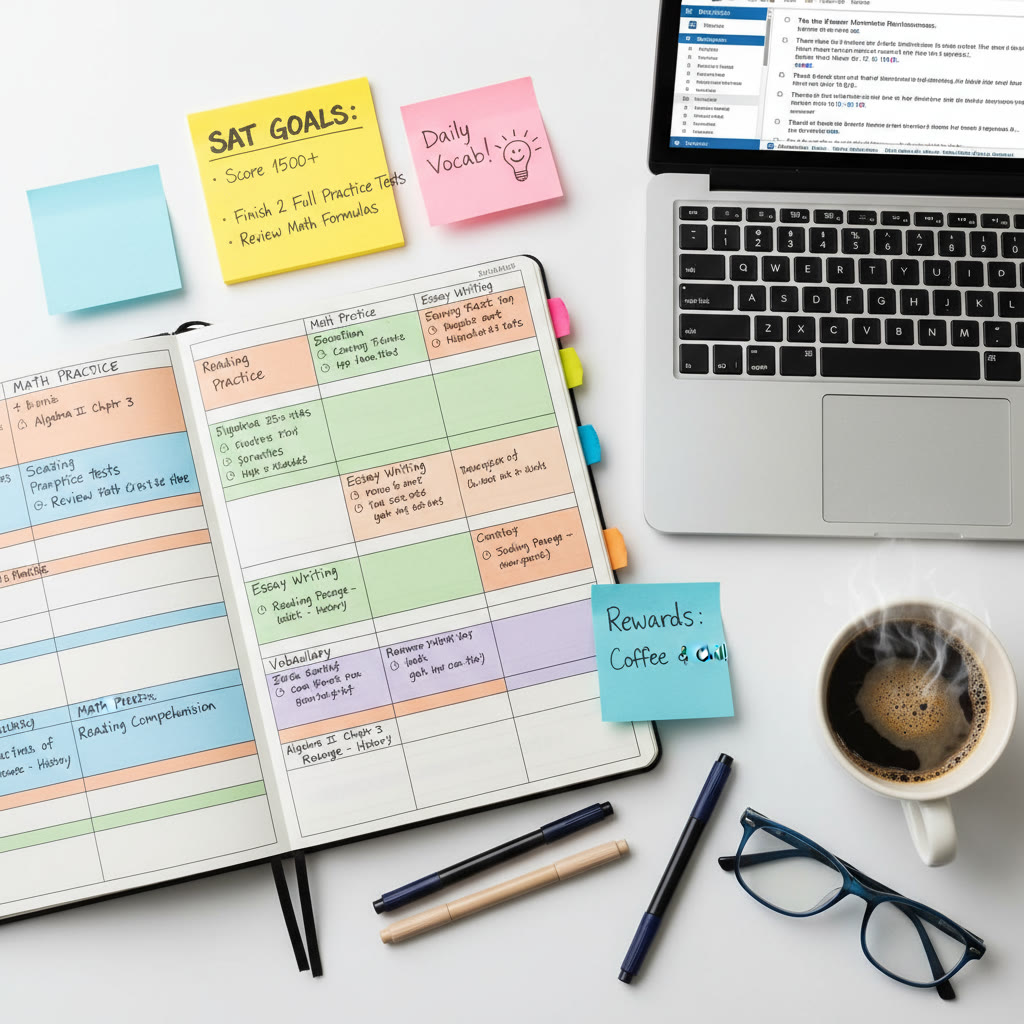How to Build a Weekly Routine for SAT Success
Think of SAT prep like training for a big race or learning to play an instrument: brief, thoughtful, and steady practice beats last-minute marathons. If you want an effective, manageable routine you can actually stick with, you need more than willpower. You need structure, variety, accountability, and the right feedback. This post walks you through a human-centered weekly plan that adapts to your life, keeps you motivated, and improves your score in measurable ways. Along the way I’ll share examples, a sample timetable, troubleshooting tips, and how targeted support like Sparkl’s personalized tutoring can amplify your progress when you need it.
Why a weekly routine beats random studying
Random practice is inefficient. You might study two hours in a single day and then skip five—your brain won’t consolidate knowledge optimally. A weekly routine creates repeated encounters with concepts, spaced repetition to strengthen memory, and predictable review slots so nothing falls through the cracks. It also offers a realistic view of effort: seeing two small sessions each day is less intimidating than imagining a ten-hour cram session the night before the test.
Plus, consistent short sessions support active recall and interleaving strategies, both proven to help long-term retention. If you plan wisely, the weekly routine becomes momentum: small wins accumulate into big score improvements.
Step 1: Anchor your week with a realistic time budget
First decide how many total hours per week you can realistically commit. Here are three common profiles:
- Minimalist: 5–7 hours/week. Good if you have heavy extracurriculars or a late start, but you must use high-quality practice and be strict about review.
- Balanced: 10–15 hours/week. A sweet spot for many students. You can do daily practice, weekly full sections, and a full test every 2–3 weeks.
- Accelerated: 20+ hours/week. For students aiming for a large jump in a short time or those juggling late test dates. This allows more diagnostic work and frequent full tests.
Choose the profile that fits your life. In a practical sense, consistency matters more than total hours, so select something you can sustain for months, not just a single week.
Step 2: Break down the week into daily blocks
Divide study into 3 types of blocks: Warm-up, Focused Practice, and Active Review. In a week these will rotate so you practice all skills without burning out.
- Warm-up (15–30 minutes): Quick practice to build momentum. A few grammar questions, a 10-minute reading passage, or a timed math problem set. Think of this as sharpening the saw.
- Focused Practice (45–90 minutes): Deep work on one domain—Math, Evidence-Based Reading and Writing (ERW), or essay-style writing. Use practice problems and error analysis.
- Active Review (30–60 minutes): Go over mistakes, re-teach yourself the rule you missed, and write a short summary or flashcard.
Example daily structure for a 10-hour/week student: two 30-minute warm-ups, three 60-minute focused sessions, and four 30-minute review sessions spread over the week.
Step 3: Weekly template that fits most students
Below is a realistic weekly template. Treat it as a starting point and tune it to your strengths and weaknesses.
| Day | Morning (optional) | Afternoon/Evening | Goal |
|---|---|---|---|
| Monday | Warm-up 20 min (vocab or grammar) | Focused Math 60 min (algebra) | Introduce skill, quick practice |
| Tuesday | Warm-up 15 min (reading) | Focused ERW 60 min (passage practice) | Timed passages, speed work |
| Wednesday | Warm-up 15 min (math) | Active Review 45 min (error analysis) | Understand common mistakes |
| Thursday | Warm-up 20 min (grammar) | Focused Math 60 min (geometry) | Practice problem types |
| Friday | Warm-up 15 min (reading) | Focused ERW 60 min (command of evidence) | Master question strategies |
| Saturday | Practice Test or Full Section 3 hours (alternate weeks) | Review Test 60–90 min | Simulate test conditions and analyze |
| Sunday | Light review 30 min | Planning 30 min for next week | Rest, reflection, goal setting |
This table is intentionally flexible. Maybe you’re a night owl who studies in the evening, or maybe you can only fit sessions on weekends—adjust the timing, not the logic.

Step 4: Build variety by alternating skills
Monotony kills focus. Alternate subjects, question types, and session intensity so your brain stays engaged and the learning strengthens across contexts.
- Mix question formats: Do some grid-ins and multistep problems on Math day, and a mix of evidence and vocabulary-in-context on ERW day.
- Rotate intensity: After a heavy practice test, plan a lighter review week to consolidate rather than piling on more tests immediately.
- Change environments occasionally: A coffee shop, library, or outdoor table can make a 60-minute session feel fresher.
Step 5: Practice tests and how to schedule them
Full-length practice tests are the single best diagnostic tool. Aim for one every 1–3 weeks depending on how many hours you have. Early on, one test every two weeks is a good cadence. In the month before the test, increase frequency to one per week if possible.
When taking a practice test, simulate real conditions: timed sections, limited breaks, and the same number of sections as the official exam. After the test, spend at least as much time analyzing your errors as you spent taking it. This is where the real learning happens.
Sample weekly schedule with time totals
Here’s a concrete weekly schedule for someone committing about 12 hours per week. Use it as a template and adapt to your calendar.
| Session | Duration | Purpose |
|---|---|---|
| Daily warm-ups (Mon-Fri) | 20 minutes each = 100 minutes | Build consistency and speed |
| Focused sessions (3 per week) | 60 minutes each = 180 minutes | Target weak areas |
| Review & error analysis (2 sessions) | 45 minutes each = 90 minutes | Deepen understanding |
| Practice test (alternate weeks) | 180 minutes + 90 minutes review = 270 minutes | Full test simulation and analysis |
| Weekly planning & rest | 30 minutes | Reflect and tune next week |
Total weekly time in a test week: ~12–13 hours. In non-test weeks, your total will be slightly lower, with more time spent on focused practice.
Step 6: Make every minute count — quality over quantity
Not all hours are created equal. An hour of distracted scrolling is worse than 30 focused minutes. Use these tips to improve quality:
- Set a single goal for each session. Don’t try to do everything at once.
- Use a timer or Pomodoro method to maintain focus—25–50 minute blocks followed by short breaks work well.
- After practice, always ask: What did I get wrong and why? This error-analysis habit is the engine of improvement.
- Write 1–3 micro-actions at the end of each session. For example: ‘Review algebra roots formula tomorrow’ or ‘Practice command-of-evidence questions for 20 minutes.’
Step 7: Track progress with simple metrics
Numbers motivate. Track a few meaningful metrics each week:
- Timed accuracy by section (percentage correct under timed conditions).
- Average time per question for problem types that give you trouble.
- Number of practice tests and score trend.
Here’s a simple progress table you can copy into a notebook to visualize improvement.
| Week | Practice Tests | Avg ERW % | Avg Math % | Notes |
|---|---|---|---|---|
| 1 | 0 | 60 | 55 | Identify weak areas, baseline |
| 4 | 1 | 68 | 63 | Improved pacing on Reading |
| 8 | 3 | 75 | 70 | Consistent error analysis paying off |
Step 8: Use strategic review, not passive rereading
Many students reread notes and feel productive, but passive review is low-return. Instead, use:
- Active recall: Cover the solution and try to recreate it from memory.
- Self-explanation: Explain why each answer is correct in 1–2 sentences.
- Spaced repetition: Revisit tricky concepts on a schedule — after 2 days, 1 week, and 3 weeks.
Step 9: Build habits that support cognitive performance
Your brain is a biological machine. Habits outside study time matter enormously.
- Sleep: Prioritize 7–9 hours. Sleep consolidates memory; late-night cramming is often counterproductive.
- Movement: Short walks or light exercise increase focus and reduce stress.
- Nutrition: Maintain steady energy with protein, vegetables, and complex carbs. Avoid energy crashes from excessive sugar.
- Mindfulness: Five minutes of focused breathing before a practice test reduces anxiety and improves concentration.
Step 10: When to get extra help
Some roadblocks you can solve yourself, but others need targeted coaching. Consider personalized tutoring if:
- You’re plateauing despite steady practice.
- Timing and pacing issues persist on test sections.
- You need tailored practice plans for a specific goal score.
Targeted support like Sparkl’s personalized tutoring can be especially helpful here because it offers 1-on-1 guidance, tailored study plans, expert tutors who diagnose patterns in your errors, and AI-driven insights to prioritize the most impactful work. A tutor can spot subtle timing habits, propose micro-adjustments, and accelerate progress in ways general study plans often miss.
How to personalize the template for different starting points
Not every student starts at the same level or learns the same way. Here are three personalization options:
- Low baseline (many content gaps): Emphasize focused content sessions, build flashcards, and schedule more review. Swap one practice test every two weeks for two focused content simulation sessions.
- Mid-level student (some consistency, small gaps): Keep regular full sections and weekly error logs. Use weekly practice tests and targeted problem sets for weaker question types.
- High baseline (aiming for small gains): Focus on precision: timing, advanced problem types, and off-by-one mistakes. Include more mixed-practice and the occasional professional tutor session for shaving points off hard questions.
Real-world example: Two students, two routines
Sam and Aisha both have three months before their test. Sam can study 8 hours per week; Aisha can study 16 hours per week.
Sam focuses on consistency: five 1-hour sessions and three 20-minute warm-ups. He takes a practice test every three weeks and reviews errors carefully. His routine is lightweight but reliable, and after three months he gains solid, steady improvements because he never burns out.
Aisha uses a heavier regimen: daily focused sessions, twice-weekly full sections, and a weekly full-length test. She pairs her work with targeted sessions from an expert tutor and leverages AI-driven insights from a tutoring platform to prioritize error patterns. Her improvements are faster, but she also schedules extra rest days to avoid fatigue.
Both approaches work because they match each student’s capacity and goals.
Common pitfalls and how to fix them
- Pitfall: Studying too many subjects at once. Fix: Focus on one core weakness per week and rotate other subjects.
- Pitfall: Ignoring timed practice. Fix: Designate at least one timed section per week.
- Pitfall: Skipping error analysis. Fix: Make a hard rule: for every hour of practice, spend at least 30 minutes on review.
- Pitfall: Burnout. Fix: Build rest into your schedule, and use lighter weeks after intense test simulations.
Motivation tips to stick with the plan
Keeping momentum is partly psychological. Try these tricks:
- Micro-rewards: Celebrate small wins like a full week completed or a new personal best on a practice section.
- Visual progress: Mark improvements on a chart so you can see upward trends.
- Social accountability: Study with a friend or check in with a tutor weekly. Even a short accountability message can keep you on track.
- Variety and challenges: Add one fun stretch goal each month, like beating your time per passage by 10%.
Last-mile tips the week before test day
Drop heavy new learning in the last 3–7 days. Shift to consolidation: review cheat sheets, practice timing, and take one last full-length test about 7 days before the exam. The final 48 hours should be light, focusing on sleep, nutrition, and light review of high-yield concepts.
If you use a tutoring service, this is a great time for a targeted 1-on-1 session to polish pacing and strategy. Sparkl’s personalized tutoring can be helpful here to create a calm, targeted final plan that prioritizes the most impactful drills and reduces test-day anxiety through practice and perspective.
Quick checklist to build your first week
- Pick a weekly hour budget you can sustain.
- Create a schedule with warm-ups, focused sessions, and active review.
- Plan one practice test every 1–3 weeks and schedule its review time.
- Track three metrics and update them weekly.
- Schedule sleep, movement, and short breaks as non-negotiables.
Final thought
Building a weekly routine for SAT success is as much about psychology as it is about content. A thoughtful, manageable plan turns ambiguous effort into measurable progress. Stick with the small habits, analyze your errors ruthlessly, and be willing to adapt the routine as you improve. If you ever feel stuck or need to compress months of progress into weeks, tailored support such as Sparkl’s personalized tutoring, with 1-on-1 guidance, tailored study plans, expert tutors, and AI-driven insights, can provide the nudge that turns steady work into a breakthrough.
Now open your calendar, block your first study sessions, and start with a 20-minute warm-up. The rest is daily practice, honest reflection, and a few well-placed adjustments along the way. You’ve got this.















No Comments
Leave a comment Cancel